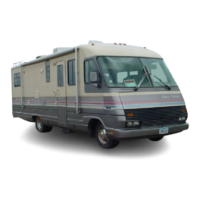22
Discovery, Discovery LXE, Pace Arrow, and Pace Arrow LXEt
Inspection:
Ensure all exterior items are
stowed or secured (i.e. TV
antenna, ceiling vents and
windows).
Check engine accessory
drive belts, hoses, battery and
engine uid levels. Inspect
the engine, transmission
and generator per the OEM
manuals.
Evenly distribute and secure
cargo. Store heavy items near
the rear axle and lighter items
toward the front to prevent
uneven stress and abnormal
handling.
Check all tires for accurate
ination pressure and
physical condition. Look
around, above and under the
motorhome for obstruction
or leaks. Test all exterior
lighting: headlamps,
taillights, brake and clearance
lights.
Inside the motorhome, store
and secure heavier objects
in the lower cabinets to
maintain a low center of
gravity for sway reduction.
Secure loose items to prevent
weight shift and damage to
cargo.
Store lighter items in the
overhead cabinets.
Close and secure all cabinet
doors and drawers, shower
and pocket doors.
Turn off interior lighting.
Adjust exterior mirrors and
check dash gauges for proper
operation.
INFORMATION:
For chassis maintenance
details refer to Chassis
section 10.
CAUTION:
Open the bay doors slowly.
Cargo may shift during
travel.
WARNING:
To avoid
injury, never
place hands
or fingers
near the
edges of the
bay door
when opening
or closing.
Always use
the latch handle. Apply
pressure with the other
hand just above the latch
handle.
TIPS:
Multi-purpose items,
versatile clothing and
periodic removal of unused
cargo will streamline cargo
storage.
HITCH
Using the Hitch Receiver
When using the hitch receiver,
remember that the motorhome is
intended for towing light loads
and is primarily designed as a
recreational vehicle. Safety and
durability of the hitch receiver
requires proper use. Avoid
excessive towing loads or other
misuse of the receiver. Towing will
affect fuel economy.
When towing a trailer or car
without use of an auxiliary
braking device, the brakes on
the motorhome must absorb the
increased energy required to stop
both the motorhome and the towed
load. This is critical and extra
awareness must be used especially
on hills and mountainous terrain
where sharp curves, steep grades
and possibly irregular road surfaces
may be encountered.
Check the motorhome Chassis
Operator’s/Owner’s Guide/
Manual for the maximum weight
the motorhome can tow and stop.
Extreme caution must be used
especially as weight of a towed
load increases.
While the motorhome has a
Gross Combination Weight Rating
(GCWR), stopping distances will
increase if the towed load is not
equipped with an auxiliary braking
device.
When weighing the motorhome,
add all passenger weight to the
GCWR total. The motorhome must
be weighed, in a fully loaded ready
to travel condition which includes
weight of fresh water, occupants,
carry on items and any vehicle or
trailer towed. Total weight must
not exceed the GCWR.
NOTE:
In most cases the GCWR of
the chassis and the finished
motorhome are the same.
In some cases, due to the
equipped hitch receiver, the
GCWR may be reduced.
Please refer to the Federal
Certification Label posted
in the motorhome for the
GCWR.
WARNING;
Most states and Canadian
provinces require trailers
and/or towed vehicles to
have adequate auxiliary
brakes and safety chains.
Failure to comply with
these State and Canadian
province requirements may
result in fines and/or pose
a safety hazard, that can
result in an accident.
WARNING;
Do not tow a trailer or
vehicle that exceeds the
rated capacity of the hitch
receiver. Overloading
the hitch receiver can
cause unusual handling
characteristics and
overstress the hitch receiver
and chassis. It could also
void the warranty. If there
are any questions, call
customer support.
020134i

